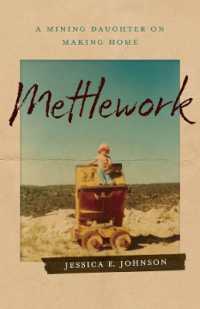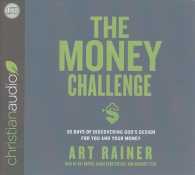Full Description
While performance-based assessment has long been a staple of education, no book covers the relevant topics for middle and high school physical education as thoroughly as this new edition of Performance-Based Assessment for Middle and High School Physical Education. This updated edition reflects the current NASPE standards and includes new ancillary materials, more examples for educators, and a new chapter about assessing fitness. This text will help you * develop assessments and implement them into your curriculum, making the assessment process a natural part of instruction; * provide feedback to students so they know what they have accomplished and what they still need to do; and * use a variety of tools-including open-response questions, game play and modified game play, and progressive assessments-to measure student learning The authors break down this complex subject into easily digestible pieces and show you how to develop assessments that will help you and your students work together to enhance the instructional process in physical education. The authors, who have over three decades of experience teaching and assessing in public schools, describe the various types of performance-based assessments and show how to implement the assessments, using numerous models as examples to be adapted to your own situations. Not only will you learn how to develop and use assessments to help students, but you will also receive unit plans for team, individual, and dual sports that you can modify for use in your own classes. You'll learn how to create rubrics, use portfolios in the assessment process, and integrate assessments into fitness education and physical education. You'll also explore the challenges with traditional grading practices and find out how to overcome those challenges. The authors provide a wealth of tools for assessing students according to local, state, and NASPE standards while helping students reach their goals. The text is supported by a Web site that includes a test package, a presentation package with PowerPoint slides, an instructor guide, and a CD-ROM that includes additional forms and assessments. Performance-Based Assessment for Middle and High School Physical Education, Second Edition, will help you develop authentic assessments and get the most out of the assessment experience. And in doing so, it will help your students experience success. Audience: Reference for middle and high school educators in developing and implementing physical activity programs. Text for education and physical education majors and for students in technology courses.
Contents
Preface Acknowledgments Part I: Introduction to Performance-Based AssessmentChapter 1. The Need for Change Call for Change in Physical Education Standards-Based Instruction Types of Assessment in Standards-Based Instruction Effect on Teaching When Standards Are Used Need for More Assessment in Physical Education Role of Assessment in Physical Education Programs Switch to Performance-Based Assessment Conclusion Chapter 2. What Is Continuous Performance-Based Assessment? Characteristics of Performance-Based Assessment Types of Performance-Based Assessment How Performance-Based Assessment Changes Instruction Advantages of Performance-Based Assessment What to Avoid When Using Performance-Based Assessment Conclusion Part II: Components of Performance-Based AssessmentChapter 3. Rubrics What Is a Rubric? Benefits of Using Rubrics Criteria for Rubrics Simple Scoring Guides Point System Scoring Guides Choices in Writing Rubrics How to Create Rubrics Special Considerations in Creating Rubrics Rubric Hints and Guidelines Conclusion Chapter 4. Developing Performance-Based Assessments Observations Game Play and Modified Game Play Role Playing Event Tasks Student Performances Journals Student Projects Student Logs Conclusion Chapter 5. Open-Response Questions Open-Response Questions Versus Essay Questions Characteristics of Open-Response Questions Types of Open-Response Questions How to Write Open-Response Questions Suggestions for Using Open-Response Questions Conclusion Chapter 6. Portfolios Characteristics of Portfolios Types of Portfolios Portfolio Guidelines in Performance-Based Assessment Evaluating Portfolios Conclusion Chapter 7. Developing Culminating and Progressive Assessments Culminating (Summative) Assessments Progressive Learning Activities and Assessments Tumbling Unit Target Archery Unit Golf Unit Conclusion Chapter 8. Planning for Continuous Performance-Based Assessment Major Unit Focus Culminating (Summative) Assessment and Evaluation Rubric Essential Knowledge, Skills, and Abilities Progressive Learning Activities and Formative Assessments Critical Resources Planning Lessons From the Unit Plan Conclusion Part III: Implementing Continuous Performance-Based AssessmentChapter 9. Continuous Performance-Based Assessment in Team Sports Major Unit Focus Culminating (Summative) Assessment and Evaluation Rubric Essential Knowledge, Skills, and Abilities Progressive Learning Activities and Formative Assessments Critical Resources How to Use the Student Soccer Portfolio Conclusion Chapter 10. Assessing Fitness and Physical Activity Participation New Strategies and Recommendations for Fitness Education and Assessment Integrating Fitness Education and Assessment into the Physical Education Curriculum Resources for Fitness Education Curriculum, Instruction, and Assessment Using Pedometers to Assess Physical Activity Participation Levels Sample Authentic Assessment Strategies for Fitness and Physical Activity Participation Conclusion Chapter 11. Effective Grading in Physical Education Purposes of Grading and Grade Reporting Developing a Meaningful Grading System Problems With Traditional Grading Practices Grade Formats in Physical Education Effective Grading in Physical Education Challenges in Using Effective Grading Practices Grading Practices for Students With Special Needs Hints and Suggestions for More Effective Grading Practices Conclusion Chapter 12. Acquiring Assessment Savvy Planning the Assessment Process Lund and Kirk's Tips for Acquiring Assessment Savvy Conclusion Glossary Bibliography Index About the Authors






